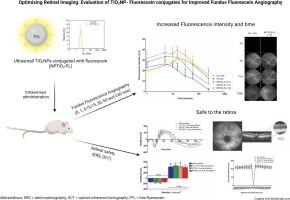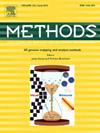优化视网膜成像:评估超小 TiO2 纳米粒子-荧光素共轭物对改进眼底荧光素血管造影的作用。
IF 4.2
3区 生物学
Q1 BIOCHEMICAL RESEARCH METHODS
引用次数: 0
摘要
眼底荧光素血管造影(FFA)已被广泛用于各种视网膜和脉络膜疾病的识别、管理和诊断,如老年性黄斑变性、糖尿病视网膜病变、早产儿视网膜病变等。临床医生可通过该检查评估视网膜形态和视网膜血管的病理生理学。然而,荧光素钠的不良反应也时有报道,从轻微到严重不等。二氧化钛纳米粒子(NPTiO2)在许多生物应用中都显示出巨大的潜力。在这些纳米粒子上涂覆或共轭小分子可增强其稳定性、光化学特性和生物相容性,还能增加纳米粒子的亲水性,使其更适合生物医学应用。这项研究展示了超小二氧化钛纳米粒子与荧光素钠共轭的潜在用途,以提高血管造影检查的质量。荧光素与 NPTiO2 共轭的策略成功地增强了造影剂的荧光光稳定性,并延长了其在视网膜中的保留时间。初步的体内和体外安全性测试表明,这些纳米颗粒对预期应用是安全的,溶血倾向低,视网膜厚度或视网膜电图 a 波和 b 波振幅无明显变化。总之,荧光素与 NPTiO2 的共轭作用产生了一种具有良好特性的纳米材料,可作为一种创新的造影剂用于 FFA 检查。通过清楚地描述我们的分析方法,我们还希望为未来的研究提供更好的视角和可重复的条件。本文章由计算机程序翻译,如有差异,请以英文原文为准。

Optimizing Retinal Imaging: Evaluation of ultrasmall TiO2 nanoparticle- fluorescein conjugates for improved Fundus Fluorescein Angiography
Fundus Fluorescein Angiography (FFA) has been extensively used for the identification, management, and diagnosis of various retinal and choroidal diseases, such as age-related macular degeneration, diabetic retinopathy, retinopathy of prematurity, among others. This exam enables clinicians to evaluate retinal morphology and the pathophysiology of retinal vasculature. However, adverse events, including from mild to severe reactions to sodium fluorescein, have been reported. Titanium dioxide nanoparticles (NPTiO2) have shown significant potential in numerous biological applications. Coating or conjugating these nanoparticles with small molecules can enhance their stability, photochemical properties, and biocompatibility, as well as increase the hydrophilicity of the nanoparticles, making them more suitable for biomedical applications. This work demonstrates the potential use of ultrasmall titanium dioxide nanoparticles conjugated with sodium fluorescein to improve the quality of angiography exams. The strategy of conjugating fluorescein with NPTiO2 successfully enhanced the fluorescence photostability of the contrast agent and increased its retention time in the retina. Preliminary in vivo and in vitro safety tests suggest that these nanoparticles are safe for the intended application demonstrating low tendency to hemolysis, and no significant changes in the retina thickness or in the electroretinography a-wave and b-wave amplitudes. Overall, the conjugation of fluorescein to NPTiO2 has produced a nanomaterial with favorable properties for use as an innovative contrast agent in FFA examinations. By providing a clear description of our methodology of analysis, we also aim to offer better perspectives and reproducible conditions for future research.
求助全文
通过发布文献求助,成功后即可免费获取论文全文。
去求助
来源期刊

Methods
生物-生化研究方法
CiteScore
9.80
自引率
2.10%
发文量
222
审稿时长
11.3 weeks
期刊介绍:
Methods focuses on rapidly developing techniques in the experimental biological and medical sciences.
Each topical issue, organized by a guest editor who is an expert in the area covered, consists solely of invited quality articles by specialist authors, many of them reviews. Issues are devoted to specific technical approaches with emphasis on clear detailed descriptions of protocols that allow them to be reproduced easily. The background information provided enables researchers to understand the principles underlying the methods; other helpful sections include comparisons of alternative methods giving the advantages and disadvantages of particular methods, guidance on avoiding potential pitfalls, and suggestions for troubleshooting.
 求助内容:
求助内容: 应助结果提醒方式:
应助结果提醒方式:


